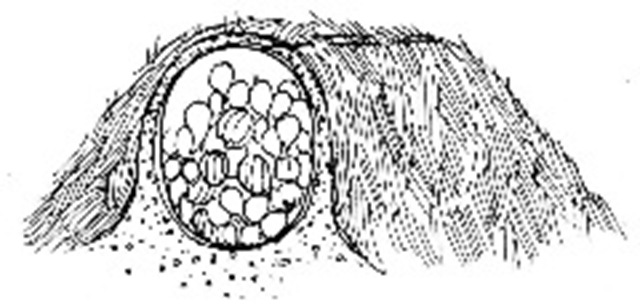If you live in a region where freezing or very snowy weather is common in winter, you’ll need to store your vegetables indoors. Your house (or possibly another building on your property) may offer several of the storage areas described in this section, or you may decide to build a basement cold storage room. If you live in an older house, there may be a fruit cellar or cold corner that could easily be closed off to stay cold and moist. Or, your newer house may have a crawl space that’s cold and damp. However it’s done, indoor storage calls for a bit more upkeep than outdoor storage, since you’ve got to keep an eye on the temperature, the ventilation, and the humidity to which your vegetables are exposed, as well as make routine checks for spoilage.

An alternative to the traditional mound method of storage is a barrel placed on its side and set in a well-drained outdoor location. Screens or wood over the opening keep out animal intruders; straw and dirt provide insulation.
straw or bedding, put in the vegetables and add packing material, if necessary. Then cover the wells with boards or more bedding. If the windows open inward, you may be able to take vegetables out from the basement, without ever having to go outside and dig!
Dry shed or attic storage
Dry shed or attic storage provides cold, dry storage — just right for onions, shallots, pumpkins, and winter squash. By “dry shed,” we mean any location that offers constant low temperatures and low humidity. This could be a garage, an unheated breezeway, a shed or storage building, even an unused doghouse, (if your garage or storage shed is fragrant with oil and gasoline, it’s no good for storing vegetables. Some vegetables will absorb the oil and gasoline fumes and odors.) In milder winter zones, shelves in a storage shed or boxes on the floor may work well. If you live in a very cold region, you may have to insulate the corner of the shed to keep the vegetables from freezing.Attic storage is convenient only if temperatures can be held somewhat constant. Since many attics will warm up quickly on a sunny day, you’ll have to construct a special little storage area In it. Choose a spot that’s well-insulated and near ventilation in the coldest part of the attic. Partition and roof it off from the rest of the attic, and use it for storing winter squash and onions.
Basement storage room
You can go all out and build a cold storage room in your basement. What you’ll be doing is creating a separate little room, insulated from heat. You can get plans for constructing indoor cold storage rooms from agricultural extension offices, lumberyards, or gardening magazines.Basically, you’ll have to partition off an area that has no heating pipes or ducts. For ventilation, there should be a window — two or more windows if the room is partitioned. For air circulation, plan to have removable slatted flooring and shelves. Slatted flooring makes it easier to use dampened sawdust or other wet material to raise the humidity.
